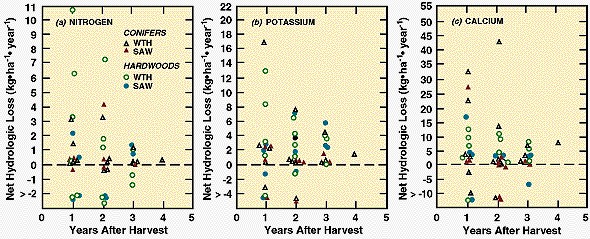


Net hydrologic losses for nitrogen, potassium, and calcium are shown
for five years after whole-tree harvesting (WTH) and saw-log-only harvesting
(SAW).

What are the effects of different intensities of forest harvest on nutrients and regrowing forests?

Timber harvest removes nutrients from forests in wood harvested and in soil erosion or rainwater leaching through the soil. Most of these nutrients can be replaced by weathering from soil minerals and from rainwater. In 11 forest stands throughout the United States, regardless of the intensity of forest harvest, the quantity of nutrients lost from the site by soil erosion or rainwater leaching was small compared to amounts removed in harvested wood. Nutrients removed in harvested wood were potentially large enough to reduce subsequent forest growth at some sites.

Mann, L. K., D. W. Johnson, D. C. West, D. W. Cole, J. W. Hornbeck, C. W. Martin, H. Riekerk, C. T. Smith, W. T. Swank, L. M. Tritton, and D. H. Van Lear. 1988. Effects of whole-tree and stem-only clear-cutting on postharvest hydrologic losses, nutrient capital, and site productivity. Forest Science 34(2):412-428.
Integrated Assessment Briefs. 1995. ORNL/M-4227. Oak Ridge National Laboratory, Oak Ridge, TN.